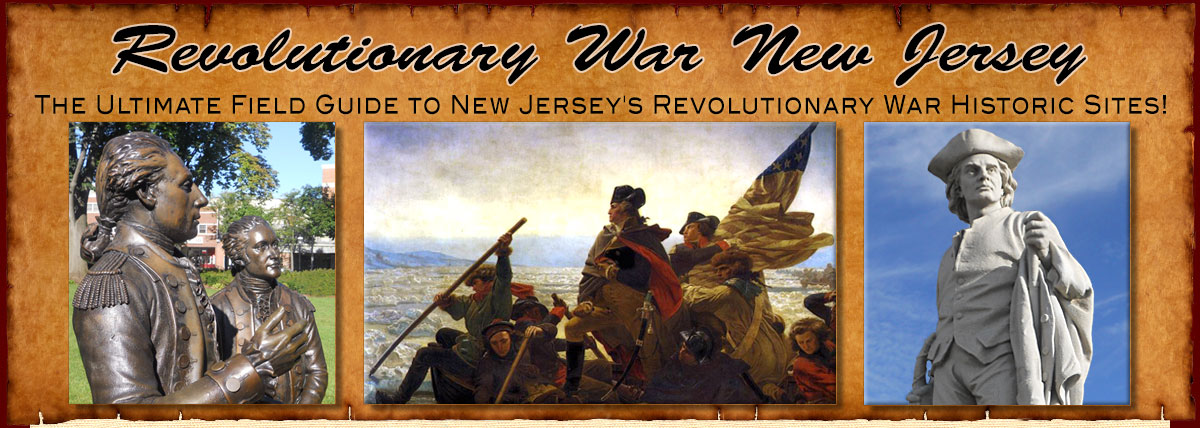

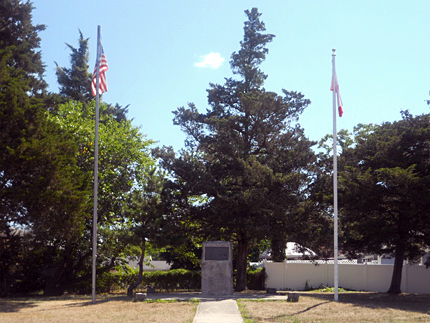
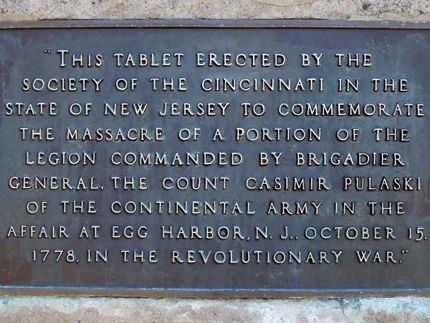
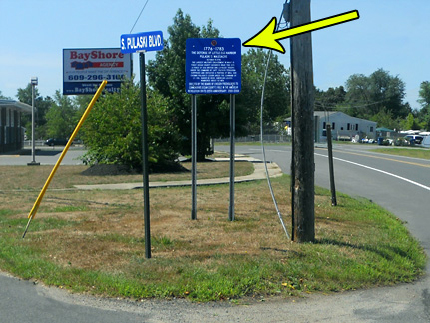
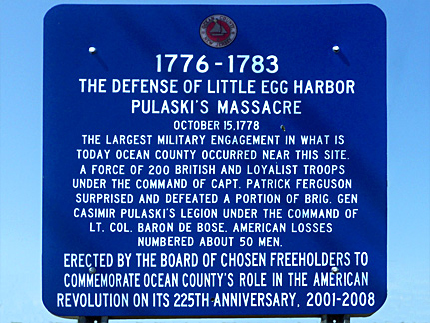
Affair at Little Egg Harbor Monument
• The monument is located in a field on S. Pulaski Blvd., between Kosciusko Way and Kadlubeck Way
• The blue sign is located 100 feet away at the corner of S. Pulaski Blvd. and Radio Rd.
Map / Directions to the Little Egg Harbor Massacre site
The Affair at Little Egg Harbor occurred near here on October 15, 1778 [1]
(Also known as the Massacre at Little Egg Harbor)
On October 6, 1778, British forces made an attack on the village of Chestnut Neck, located about five miles southwest of here. Afterwards, the British ships involved in the attack remained in the waters of Little Egg Harbor, waiting for weather conditions to allow them to sail safely back to British-occupied New York City.
(See the Port Republic page for details of the Battle of Chestnut Neck.)
A group of American soldiers under the command of General Casimir Pulaski had been sent to defend Chestnut Neck, but they did not arrive in the area until October 8, two days after the Battle of Chestnut Neck. They encamped in Little Egg Harbor Township, where they could keep an eye on the British ships still in the waters nearby. One group of fifty of Pulaski's soldiers made their camp near where the monument now stands, on what was known as Ridgeway Farm. Pulaski made his headquarters about a half mile to the west, on what was known as Willets Farm. Other groups of his soldiers were encamped nearby.
On October 13, the British in the harbor received information of the camp position and troop strength of Pulaski's forces, and they decided to make a sneak attack. [2] Two hundred and fifty British soldiers under the command of Captain Patrick Ferguson came ashore at the southern tip of Little Egg Harbor Township late on the evening of October 14. [3] The area where they came ashore is known as Osborn Island, because it was owned by a Quaker family named the Osborns. Ferguson and his men forced a member of the family, 29-year-old Thomas Osborn, to act as a guide to lead them to Pulaski's forces. They traveled through the dark along a road called Island Road (present day Radio Road).
Early on the morning of October 15, Ferguson's men made a surprise attack on the group of about fifty of Pulaski's troops encamped on Ridgeway Farm near here. They killed or wounded most of them, and took only about five prisoners. [4] When Pulaski heard the sound of gunfire, he rushed to the scene with his cavalry. However, the British had attacked and left so quickly that Pulaski's men arrived after the British were already gone.
Pulaski's troops attempted to go after Ferguson's troops but were unable to catch them. Ferguson's men had removed the planks from a bridge on Island Road, leaving Pulaski's troops unable to cross.
Ferguson's troops made it back to the British ships in the waters outside Little Egg Harbor. The ships remained there for another week, because weather conditions prevented them from leaving sooner. Eventually, they were able to leave on October 22, when they sailed back to New York City.
Casimir Pulaski and Patrick Ferguson after the Affair at Little Egg Harbor.
In the two years following the Affair at Little Egg Harbor, Casimir Pulaski and Patrick Ferguson both lost their lives in Revolutionary War battles. By coincidence, each was killed in a battle which took place in the South, and they died in the two following Octobers - Pulaski in October 1779, and Ferguson in October 1780. Brief bios of these two officers appear below.
Casimir Pulaski
General Casimir Pulaski was born on March 6, 1745, in Warsaw, Poland. In 1777 he came to America to fight on the American side in the Revolutionary War. He commanded a group of cavalry which was formed in 1778 [5] known as Pulaski's Legion, and he is remembered as the "Father of American Cavalry." He died on October 11, 1779 from wounds suffered at the Battle of Savannah, Georgia.
In 2009 Pulaski was made an Honorary Citizen of the United States. [6] Honorary Citizenship has rarely been granted; only eight people in the entire history of the United States have received it. Two of the others who have received Honorary Citizenship were also European officers who fought for the American side in the Revolutionary War: Marquis Lafayette of France, and Bernardo de Gálvez of Spain. [7]
There are a notably large number of monuments to General Pulaski in New Jersey. There are statues of him in Garfield, Paterson, Pennsauken, and Wallington. In addition to these, there is a sidewalk plaque in North Arlington honoring Pulaski, and the Pulaski Skyway is named for him.
Patrick Ferguson
Patrick Ferguson was born on June 4, 1744 in Scotland. He is known for having designed the Ferguson Rifle, which could be loaded and fired much faster than previous rifles used in warfare. It was used in a few battles by British forces during the Revolutionary War.
Ferguson came to America to fight in Revolutionary War in 1777 as a captain in the British Army. He was wounded on September 11, 1777 at the Battle of Brandywine, and he spent several months recovering. Although he returned to active duty, his right arm was permanently damaged.
Ferguson was promoted to Major on October 25, 1779, a year after the Affair at Little Egg Harbor. He died at the Battle of Kings Mountain in South Carolina on October 7, 1780, almost a year after Pulaski died, and almost two years since the affair at Little Egg Harbor. [8]
In an interesting side note which ties these events to a later era in American history, Davy Crockett's father is believed to have fought on the American side at the Battle of Kings Mountain, where Ferguson lost his life. [9]

1. ^Information about the Affair at Little Egg Harbor was drawn from a number of primary and secondary sources, including:
• William S. Stryker, The Affair At Egg Harbor New Jersey October 15, 1778 (Trenton: Naar, Day & Naar, 1894)
Available to be read at Google Books here• Franklin W. Kemp, A Nest of Rebel Pirates (Egg Harbor City, NJ: The Laureate Press, 1966) Pages 43-52
• "Expedition to Egg Harbor," New-York Gazette and Weekly Mercury, October 26, 1778, reprinted in:
Francis B. Lee, Archives of the State of New Jersey, Second Series, Vol II (Documents Relating to the Revolutionary History of the State of New Jersey / Extracts from American Newspapers relating to New Jersey) (Trenton: John L. Murphy Publishing Company, 1903) Page 219
Available to be read at the Internet Archive here• Extract of a letter from General Count Pulaski to Congress
Francis B. Lee, Archives of the State of New Jersey, Second Series, Vol II (Documents Relating to the Revolutionary History of the State of New Jersey / Extracts from American Newspapers relating to New Jersey) (Trenton: John L. Murphy Publishing Company, 1903) Pages 486-488
Available to be read at the Internet Archive here• Pat Ferguson letter, Little Egg Harbor, October 15, 1778; Published in The Royal Gazette, March 10, 1779; reprinted in:
William Nelson, Editor, Documents Relating to the Revolutionary History of the State of New Jersey, Second Series, Vol. III (Trenton: John L. Murphy Publishing Company, 1906) pages 158–159
Available to be read at the Internet Archive here2. ^ The information was supplied to Ferguson by Carl W. J. Juliat. Juliat had been a Hessian officer, fighting on the British side, who deserted and then served with the Americans, before deserting the Americans while at Little Egg Harbor. For more about his story, see:
Franklin W. Kemp, A Nest of Rebel Pirates (Egg Harbor City, NJ: The Laureate Press, 1966) Pages 46-47, and 82-84.3. ^ Some of these troops were British soldiers of the 5th Regiment of Foot. Some were marines from the British ships.
Others were of the Loyalist 3rd Battalion of New Jersey Volunteers. The Loyalists were Americans who remained loyal to the British and fought on their side in the war.
Franklin W. Kemp, A Nest of Rebel Pirates (Egg Harbor City, NJ: The Laureate Press, 1966) Page 474. ^ Different casualty numbers were reported by both sides, which is not uncommon with Revolutionary War battles.
Pulaski reported that "Our loss is estimated, dead, wounded and absent about 25 or 30 men, and some horses. That of the enemy appears to be much more considerable."
Ferguson stated there were "about fifty" American dead. He reported low casualties among his own British forces: 2 dead, 1 missing, and 2 wounded.
These figures and quotes were drawn from:• Extract of a letter from General Count Pulaski to Congress
Francis B. Lee, Archives of the State of New Jersey, Second Series, Vol II (Documents Relating to the Revolutionary History of the State of New Jersey / Extracts from American Newspapers relating to New Jersey) (Trenton: John L. Murphy Publishing Company, 1903) Pages 486-488
Available to be read at the Internet Archive here• Pat Ferguson letter, Little Egg Harbor, October 15, 1778; Published in The Royal Gazette, March 10, 1779; reprinted in:
William Nelson, Editor, Documents Relating to the Revolutionary History of the State of New Jersey, Second Series, Vol. III (Trenton: John L. Murphy Publishing Company, 1906) pages 158–159
Available to be read at the Internet Archive here5. ^ Continental Congress, Saturday, March 28, 1778:
Roscoe R. Hill, Editor, Journals of the Continental Congress, 1774-1789, Volume X. January 1 - May 1, 1778 (Washington D.C. : Government Printing Office, 1908) page 290
Available to be read at the Internet Archive here
6. ^ Congressional Record: Senate: Vol. 155, Part 5 (Washington D.C. : Government Printing Office, 2009) pages 6153 - 6154
Available to be read at Google Books here7. ^ The other five people granted Honorary United States Citizenship are: Winston Churchill, Raoul Wallenberg, William and Hannah Callowhill Penn, and Mother Theresa. Only Churchill and Mother Theresa received the Honorary Citizenship while they were alive. All other received it posthumously.
See the document:
U.S. Department of State Foreign Affairs Manual Volume 7 – Consular Affairs / HONORARY CITIZENSHIP, which is available to be read on the U.S. State Department website here
▸ Note that Pulaski and de Gálvez are not listed in this document, because it was published in 2008, before either had been granted the honor.
• Pulaski was granted Honorary Citizenship in 2009 (See Source Note 6)
• Bernardo de Gálvez was granted Honorary Citizenship in 2014 (See H.J.Res.105 - Conferring honorary citizenship of the United States on Bernardo de Gálvez at the Library of Congress website here)8. ^ A longer biographical sketch of Ferguson, written by Dr. M. M. Gilchrist, can be found on the Brandywine Battlefield Historic Site website.
9. ^ Bob Thompson, Born on a Mountaintop - On the Road with Davy Crocket and Ghosts of the Wild Frontier (New York: Broadway Books, 2013) Pages 14-20
▸ For more information about this book, see the website www.authorbobthompson.com